
European Shag: The Coastal Sentinel
Introduction to the European Shag
The European Shag, scientifically known as Gulosus aristotelis, is a captivating seabird that belongs to the cormorant family, Phalacrocoracidae. Known for its sleek plumage and distinctive crest during the breeding season, this bird is a common sight along the rocky coastlines of Europe, playing a vital role in its coastal ecosystems.
Physical Description
The European Shag is a medium-sized bird, typically measuring about 68-78 cm in length with a wingspan of 95-110 cm. It exhibits a dark greenish-black plumage, which appears glossy and iridescent in sunlight. One of its most notable features during the breeding season is the crest on its forehead, which adds to its distinguished appearance. The bird also has bright green eyes, a slender bill, and webbed feet suited for its aquatic lifestyle.
Habitat and Distribution
This shag predominantly inhabits coastal regions, favoring rocky cliffs, islands, and inlets. Its range extends across the northeastern Atlantic from Iceland and the Faroe Islands, down through the British Isles to the Mediterranean and the Black Sea. It is particularly common in the North Sea, including along the coasts of Scandinavia and the British Isles.
Breeding and Nesting Habits
European Shags are colonial nesters, often found in large groups on cliff ledges or rocky outcrops near the sea. They build their nests from seaweed, twigs, and other marine debris. These nesting sites are crucial for their mating rituals and raising their young.
Egg Laying and Incubation
The female typically lays 3 to 4 eggs in a single breeding season. Both parents share the duty of incubating the eggs, which lasts for about 31-33 days. The nests, sometimes reused in successive years, become robust structures due to continuous additions of materials.
Chick Rearing and Parental Care
Once hatched, the chicks are fed a diet of regurgitated fish by both parents. They grow rapidly and are usually ready to fledge in about 7-8 weeks. During this period, the chicks learn essential survival skills, particularly diving and fishing.
Diet and Feeding Behavior
The European Shag primarily feeds on a diet of small fish, supplemented by cephalopods and crustaceans. They are excellent divers and can plunge from the air or dive from the surface, swimming underwater using their webbed feet to chase prey. Their slender beak is perfectly adapted for catching fish.
Migration and Movement
While the European Shag is mostly sedentary, some populations, particularly those in the colder northern regions, may move southwards during winter. Juvenile birds also tend to disperse more widely than adults, exploring new feeding grounds.
Conservation Status
The European Shag is currently classified as Least Concern by the IUCN. However, it faces threats common to many seabirds, including pollution, overfishing, and disturbance to breeding colonies. Conservation efforts focus on protecting their natural habitats and ensuring sustainable fish populations.
Conclusion: The Alluring European Shag
The European Shag, Gulosus aristotelis, with its striking appearance and remarkable diving skills, is an integral part of the marine ecosystem along Europe's coastlines. While not found in Utah, its existence adds to the global avian diversity and is a subject of interest for birdwatchers and conservationists worldwide. Understanding and appreciating the role of the European Shag in its natural habitat is crucial for the preservation of the species and the health of coastal ecosystems.